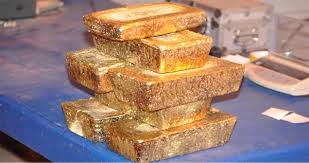
I have often wondered if any of the smaller gold producers have ever considered modelling their business plan similar to a gold Exchange Traded Fund (“ETF”).
This hybrid business model may be a way for companies to provide shareholders a way to leverage themselves to physical gold rather than leveraging to the performance of a mine.
Let me explain further
Consider two identical small mining companies each starting up a new mine. Their projects are identical; 2 million gold ounces in reserves with annual production rate of 200,000 ounces with a 10 year mine life. On an annual basis, let’s assume their annual operating costs and debt repayments could be paid by the revenue from selling 180,000 ounces of gold. This would leave 20,000 gold ounces as “profit”. The question is what to do with those 20,000 ounces?
Company A
Company A sells their entire gold production each year. At $1200/oz, the 20,000 oz gold “profit” would yield $24 million. Income taxes would be paid on this and the remaining cash can be spent or saved.
Company A may decide to spend more on head offices costs by adding more people, or they may spend money on exploration, or they could look at an acquisition to grow the company. There are plenty of ways to use this extra money, but returning it to shareholders as a dividend isn’t typically one of them.
Now let’s jump forward several years; 8 years for example. Company A may have been successful on grassroots exploration and added new reserves but historically exploration odds are working against them. If they actually saved a portion of the annual profit, say $10M of the $24M, after 8 years they may have $80M in cash reserves.
Company B
Company B only sells 180,000 ounces of gold each year to cover costs. It puts the remaining 20,000 ounces into inventory. Their annual profit-loss statement shows breakeven status since their gold sales only cover their financial commitments. In this scenario, after 8 years Company B would have 160,000 gold ounces in inventory, valued at $192 million at a $1200 gold price.
If you’re an investor looking at both these companies in the latter stages of their mine life, which one would you rather invest in?
Company A has 400,000 ounces (2 years) remaining in mineral reserves and $80M cash in the bank. Company B also has 400,000 ounces of mineral reserves and $192 million worth of gold in the vault. If I’m a bullish gold investor and foresee a $1600/oz gold price, then to me Company B might theoretically have $256M in the vault (160k oz x $1600). If I’m a super bullish, their gold inventory could be worth a lot more..theoretically.
Which company is worth more?
I assume that the enterprise value (and stock price) of Company A would be based on its remaining reserves at some $/oz factor plus its cash in the bank. Company B could be valued the same way plus its gold inventory. So for me Company B may be a much better investment than Company A in the latter stages of its mine life. In fact Company B could still persist as an entity after the mine has shutdown simply as a “fund” that holds physical gold. If I am a gold investor, then Company B as an investment asset might be of more interest to me.
If Company A had good exploration results and spend money wisely, then it may have more value but not all companies are successful down this path.
Conclusion



 My question is why not stockpile the extra gold and wait for gold prices to rise? This might be an option if the company doesn’t really need the money now or doesn’t plan to gamble on exploration or acquisitions.
My question is why not stockpile the extra gold and wait for gold prices to rise? This might be an option if the company doesn’t really need the money now or doesn’t plan to gamble on exploration or acquisitions.
First of all, company B has to pay taxes on their gold. At a 30% tax rate that would amount to roughly $58 million, which brings their poke down from $192 million to $134 million. That’s still more money than company A has saved at $80 million, so presumably A has spent $54 million on exploration or other investments that didn’t work out. Too bad…so sad…that’s the nature of the business.
What your thesis really boils down to is whether a company that finds a mine should continue to explore after their first success or whether they should stop exploring and call it a day after the first mine expires. Presumably a good company with good people will use their income wisely and will find other deposits to sustain their cash flow. Since I only invest in good companies (hee hee!!) I’ll invest in company A rather than B.
A word on share price…analysts recommend share price based on the discounted expected future earnings. People purchase shares on the same expectation. What is the value today of a share in a company with no earnings for 10 years, vs the value today of a company with steady earnings every year?
True, but what is the NPV of a company with 2 years left or 1 year left in its mine – maybe close to zero. But what if those guys had 200,000 oz sitting in the vault; it’s a different company. I think the point is if gold is $1100 now, should you sell 100% of your production at that “low’ price or only sell what you need to pay expenses and then gamble you can sell the rest at a higher price in the future. If gold drops, it was bad idea but if gold rises you can pat yourself on the back for not selling everything at $1100.
It sounds like you are discussing a real options valuation issue. ie. what is the dollar value of holding the option to defer cash flow?
https://en.wikipedia.org/wiki/Real_options_valuation
I think the precursor to Goldcorp (Dickensen) did that back in the ’80’s or ’90’s. Rob McEwen was president at the time. I don’t know if it made money or not. Gold didn’t really take off until around 2007.
Every company had to decide what to do with retained earnings, which is really what unspent earnings are. There are a multitude of options and simply holding them in a vault is one option I guess.